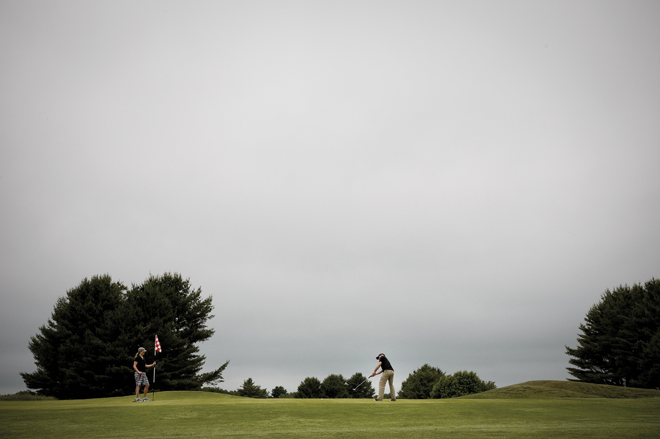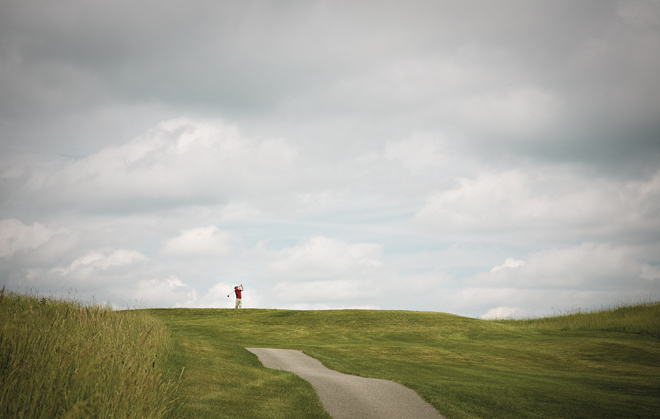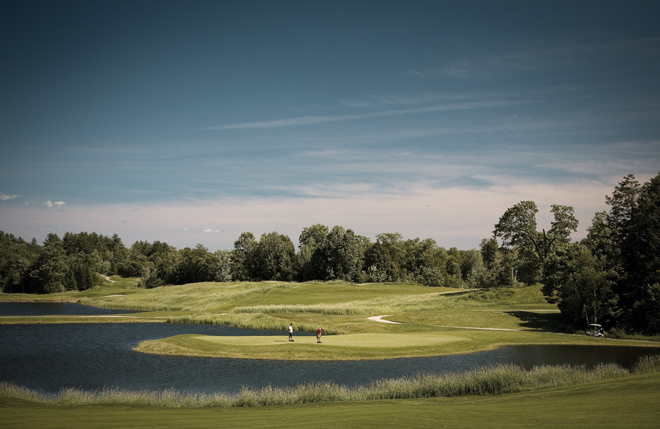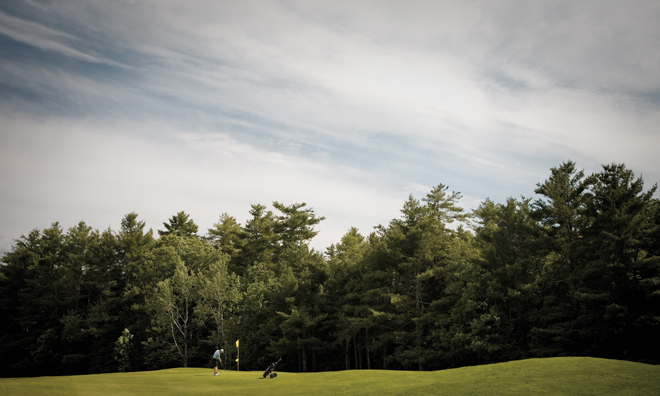Man vs. Golf
FEATURE-August 2011
By Stephen Abbott
Photographs by Mark Yaggie
Chasing the obsession across Maine
RULE #1 Every Golfer Is a Lover Spurned
To many who have never played the sport, golf is a ridiculous-seeming endeavor that still carries the pungent waft of country-club elitism from bygone eras. But to those who actually play, golf is a glittering diamond in the hands of a bent-kneed beloved—an incredibly hard thing that inspires both flushed excitement and unaccountable yearning. Despite both appearances and reputation, golf is not only played by more people today than ever before, but it is also one of the most egalitarian sports around: even the best golfers will, in time, hit the worst shots. If you are playing well, it just means you are not yet playing poorly. In golf, one is always playing against oneself, so there are few ways to win and countless ways to lose.
I have watched untold numbers of golfers pay good money for five hours of unremitting frustration and then return eagerly for more the following week. I have seen clubs fractured and golf carts crashed in bouts of crazed exasperation. I have dived out of the way of a twirling putter thrown in anger and become embroiled in several on-course altercations, one of which nearly came to fisticuffs. I have spent untold amounts of my modest disposable income on rounds of golf and the latest high-tech gear, all of which fell short of what I had hoped but none of which I will ever regret. And I have experienced moments of such transformative peace and serenity that the grinding mechanisms of my brain disengage and shift into a higher, more enlightened gear.
Golf beguiles with natural beauty and the promise of evanescent greatness. It lures the unsuspecting with the siren call of carefree recreation, only to dash them, again and again, on the rocky shoals of fierce, bittersweet addiction. Yet it’s the quixotic quest for unattainable perfection that makes golf the most philosophical, even the most mystical, of sports, as well as the most confounding to those uninitiated in its esoteric rites. Above all, it is an ardent love that will, because it must, remain forever unrequited. For love in its purest expression is the hunt, not the capture. It is the heat of the campaign, not the liberation of the conquest. If it were otherwise, it would not be golf.
RULE #3 Avoid the Prudent Play
Nonesuch River Golf Course is always one of the first courses in Maine to open for the season, and every year I make my pilgrimage on opening weekend to unleash six months of pent-up obsession. As usual, the course is overrun with middle-aged golfers swaddled in layers of synthetic athletic wear and winter hats, most of whom can be seen performing minimalist stretch-like motions or practicing spastic swings that have clearly become even more rigidified and deformed over the winter months. Ahhh, it’s good to be back with my brethren.
I step up to the tee, take my first swing of the year, and hit it dead straight…up in the air. My cloud-scraping pop fly leaves me behind a tree and a long way from the hole. Like golfers everywhere, I do not consider the safe or reasonable play. Instead, I opt for a preposterous low-probability shot that I will need to keep beneath hanging branches and curl about thirty yards to the left. I have not swung a club since October, and yet I don’t hesitate to attempt a shot that a PGA Tour professional would pull off maybe 10 percent of the time. (In the interest of avoiding a lengthy narrative, I will spare you the tawdry details of what followed.) In many ways, this moment of wild, reckless abandon encapsulates the game of golf, which is a continually renewing wellspring of unfounded athletic optimism flying in the face of overwhelming evidence that you stink. All golfers have to believe they are better than they are—it’s how we make it through 18 holes.
I don’t know how they do it, but Nonesuch comes alive in mid-season form every April, while other courses struggle for months to recover from the ravages of Maine’s harsh winters. The course is in fantastic condition for so early in the spring, but only the first nine holes are open. The back nine, I imagine, is still covered in obstinate snow piles clinging Frosty-like to life. On the par-three fourth hole, where the cart path has apparently needed to be plowed, I encounter one such obstinate pile when my shot ends up in a massive snow berm lining the hole. I take a big splashy thrash of a swing that throws up a blinding explosion of slush and ice. I’m looking all around the green to see where my ball ended up, before glancing down to find it sitting in the scooped-out hole I just created. During these first few rounds of the year, I often can’t tell which is more numb: my hands or me and my fellow golfers who can’t wait another two weeks for the world to thaw.
When I come around to play the front nine a second time, I get paired with Daniel Hourihan, the owner of Nonesuch, and Mike Cloutier, the director of golf for Point Sebago Golf Course. Dan is a generous and welcoming human being, and his course reflects his personality—which is almost certainly why it’s packed all season long and why I find myself playing so many rounds here. While yacking between holes, Mike invites me to play his course. How can I refuse? A true golfer never turns down the invitation to golf.
RULE #5 Seize the Opportune Excuse
A few weeks later, I call up Mike at Point Sebago Golf Course and schedule my round. I ask him to pair me up with some local characters, and he says, “I’ll send you out with Jim—he’s one of our club champions.” Great, Mike, thanks. Like I don’t already have enough doubts about my masculinity. When I arrive, I shake hands with Jim, who turns out to be a retired plastics engineer, Dick, a former commercial pilot, and Tony, a semi-retired radiologist. “You know what I like about this course?” Jim says. “There isn’t a single hole I don’t like.” Jim’s assessment proves prophetic, since I end up liking them all as well.
It’s the first semi-sunny day following two weeks of drenching rain, and the course is lush, verdant, and soggy. Water squishes up around our shoes, and balls bury themselves in the mushy grass. I feel vaguely guilty about marring the otherwise undefiled fairways when I send a few flopping, beaver-pelt strips of wet sod flying after a shot.The extreme weather left the perfect greens so waterlogged that morning they couldn’t be mowed, and consequently they are unusually hairy and playing snail-slow—in our minds at least. It doesn’t matter that the variance in rolling speed just barely falls within the range of human sensory perception, our group pounces, heartily welcoming the convenient excuse for the veritable cornucopia of three-putts spilling out of us. “Boy, these greens sure are slow today,” Dick says generously after yet another one of my putts comes up pitifully short. “Yeah, they’re the nicest fairways I’ve ever putted on,” I reply.
Throughout our round, I’m struck by the summer-camp atmosphere of Point Sebago. Jim and Dick, both local residents and members, stop to chat with at least a dozen people during our round, greeting them all with a “hey, how are ya” chumminess. There’s something about golf that inspires an instant sense of familiarity and fellowship, and the golf course remains the only place in my adult life where I consistently witness grown men offering praise and encouragement to one another. Would war and strife even exist if all the world was a golf course? I try to not to dream such Utopian dreams.
For our group, it’s a day of highs and lows, golf-wise, and stunning shots and unlikely par saves are soon followed by dispirited head shaking and low-decibel groans. Near the end of our round, with humidity fatigue setting in, Jim pulls off a titanically difficult 175-yard shot out of dense rough that narrowly averts a greenside bunker and stops, improbably, a few feet short of the hole. Suddenly reenergized and practically high kicking with delight, he flashes me a big smile and says, “Even the old blind squirrel finds a nut once in a while!” We both know that it’s the seductive, heady elation of these moments that keeps us coming back.
RULE #9 All Great Shots Shall Go Unobserved
Old Marsh Country Club is one of Maine’s newest courses, and I had heard so many good things about it that I’ve been meaning to play it for a while. From many vantages, the course still looks freshly hacked from the scrub and pine of the southern Maine woodland, and its design reflects modern trends in golf-course architecture: sculpted, rolling strips of slender fairway; tightly mown greens with swales and bumps; deep, fuzzy-browed bunkers shaped like amoebas; and carefully engineered views from the tee that make landing areas for your shot look more dangerous than they in fact are. The course has not one but two holes shaped like the horn of Cape Cod—you tee off in Provincetown and putt somewhere south of Boston. Much like the first girl I ever asked out, Old Marsh is hypnotic beauty suffused with knee-knocking intimidation.
Given the course’s relative difficulty, I acquit myself extraordinarily well, which is to say that I manage not to lose my ball. On the 15th hole, the aptly named “Waterloo”—both for the abundance of water fronting the thin green and for, I assume, it’s propensity to induce historic defeats of Napoleonic proportions—I somehow hit a high, glorious, flag-seeking shot that lands ever so gently, like a butterfly with sore feet, right next to the hole. Yet the steeply inclined curvature of the green sends it skittering to the right, where it ends up perched on a slope maybe eight feet from the cup. Like a scene from scripture, the clouds part and a beam of resplendent light streaks across the sky to bathe me in its divine warmth. I hear angels singing. I look around to see if any sad-sack duffers had the privilege to observe my shot. The course, of course, is empty. Crickets.
Looking over my putt, I can see the line to the hole like it was painted Day-Glo orange. My birdie is a foregone conclusion. The gods have foreordained it. It will be so. Yet when my second putt stops an eighth of an inch short of the cup, so does my broken heart. Winged demons cackle and flutter around me as I limp dejectedly to the next hole, my head hung, my legs suddenly riven with exhaustion. But like every player since the first games of gowf were played on the blustery moors of Scotland, I vow to return—and to bend the very fabric of space-time if necessary—and make this hole submit to my will.
RULE #13 The Ball Must Be Played as It Lies
Coming off some uncommonly solid play the previous week, I decide to end my early-season tour of the myriad permutations of humility with a true test of golf: a challenging course in tournament conditions. When I pull in to Kebo Valley Golf Club, the parking lot is packed. It’s the day before the annual Paul Bunyan Amateur Golf Tournament, and golfers from every corner of the state are getting in a practice round. I get paired up with Sam, an Aroostook County resident who works for a potato broker. Early in the round, Sam says, “If you don’t hunt or fish, there’s not much to do up there but play golf.” After he knocks a few in the hole from off the green, including one out of a gnarly bunker, it becomes clear that Sam has indeed spent a considerable amount of time on the golf course.
Kebo wends its way though a pristine valley on Mount Desert Island, and every elegantly constructed hole is played beneath majestic peaks of pine and exposed granite. Built in 1888, long before the invention of high-precision mowers, its greens were designed for lengthier, stickier grass that necessitated sound whacks with the putter. But to make tournament play more, um, interesting, the undulating, devilishly steep greens were sheared buzz-cut close and flattened with a heavy roller, so they are playing lighting quick—like pool tables in hell. I hit one shot from off the green that I think is pretty good. It rolls to a stop about two feet from the hole, where it wobbles, for the merest twinkling, before beginning a slow, trickling decent back to the same spot from which it was just hit. Standing there looking down at my ball, I reflect on the Sisyphean nature of the sport. We golfers are forever doomed to reach ecstatic heights, only to return—speedily, inescapably—back to the depths of shank and slice.
In life, every moment presents us with a choice. Do we accept the realities of our situation or do we turn away from hard truths? Do we give up or do we try again? Do we lapse into despair or do we embrace, even celebrate, the magisterial absurdity of the universe? I pause to survey the exquisite scene around me and inhale a lungful of crisp island air. Then I step back up to my ball and ready myself to hit it again.
Abbott’s Picks: A few more must-play Maine courses
Fox Ridge Golf Club
Pound for pound, Fox Ridge may just be the best golfing deal in Maine. A wonderful design, perfect condition, and super-nice people. From the regular tees, the course is a tough but fair test of golfing prowess, but the black championship tees, which can add a few dozen yards to a hole, will bring average golfers to their knees. The signature par-three fifth is a long downhill shot to an oblong peninsula of grass looping into a pond.
Spring Meadows Golf Club
Spring Meadows rivals nearby Fox Ridge as one of the best golfing deals in Maine. The course is always perfectly manicured, and the fairways are so plush and spongy that you almost feel like you are hitting off a tee—or cheating. Every hole has its own personality, and you could play the course a thousand times and not get bored. Every time I finish a round, I just want to walk back to the first tee and start all over again.
Cape Arundel Golf Club
Established in 1896, Cape Arundel has stood the test of time. “I’ve been here for thirty years and I’m still not tired of it,” says head pro Ken Raynor. During high summer, Cape Arundel takes on the appearance of a Scottish links-style course—a wide-open, windswept landscape punctuated by tuffs of golden hay. Immaculate fairways flow into multi-tiered greens, and a serpentine tributary of the Kennebunk River meanders through the middle of the course.
The Links at Outlook
Set against a farmland backdrop featuring a silo and cows, the first nine holes traverse a nearly treeless pasture, while the second nine sends you tumbling over forested hills and dales. On busier summer weekends, wild shots from nearby holes occasionally sail overhead, but if you survive the strafing you will be treated to spectacular vistas, carpet-like fairways, and a distinctive layout that guarantees fun will be had.
Belgrade Lakes Golf Club
Widely considered to be one of the country’s premier public courses, Belgrade Lakes is “all about golf,” according to managing partner Kyle Evans. There are no fancy amenities, just a modest clubhouse overlooking the lakes below and miles of world-class golf with nary a house in sight. The course’s picturesque clusters of granite boulders are the remains of glacial retreat, and several holes require precise, strategic shots into unblemished greens.
Bonus Pick: Northeast Harbor Golf Club
“This course has always been a hidden gem,” says head pro Rob Gardner. I couldn’t agree more. While a few holes can be seen from the road, Northeast Harbor’s secrets are revealed when you head up into its sylvan hills. Surrounded by a nature preserve and crisscrossed by hiking trails, the course is probably the closest you’ll come to golfing in a national park. So much wildlife is fluttering about and scurrying underfoot that it’s reminiscent of scenes from Bambi. On the fourth tee, follow the sounds of rushing water to a babbling waterfall traversed by a rough-hewn wooden bridge. Dramatic changes in elevation on several holes make for visually arresting scenes, and tee shots plunge, for what seems like minutes, to rolling ribbons of fairway below. The small, round greens are perfectly manicured, but their waving furrows and folds will test even the best of putters. From July 1 through Labor Day, the course is only open to members, but its low public rates in the shoulder months make it a ridiculously good deal. If you ever find yourself on Mount Desert Island, stop in and play it—whether you’re a golfer or not, you won’t be disappointed.
Bonus-Bonus Pick: Causeway Club
Before you leave the island, complete your tour of Mount Desert’s three golf courses by sneaking in a round at the Causeway Club in Southwest Harbor. Maine has an abundance of tucked-away, nine-holes courses with oodles of character, but Causeway is something special. A few holes are played along the shores of an unspoiled tidal inlet, including the second, one of my favorites, which requires players to their tee shot over an elbow in the cove. Causeway is the kind of course that inspires deep devotion and affection. The first time I played it, I met Les Thurston, a proud “Bass Harbor boy” and member who, at two months shy of 90 years old, was not only still out there golfing, but had been playing Causeway for more than 75 years—ever since he started caddying in 1935 for 35 cents a round.
A Glossary of Golf (For the Uninitiated)
GOLF: an alleged leisure activity that commences with hope and culminates in defeat | GOLFERS: exasperated, unathletic individuals prone to outbursts of cussing | BALL: a three-dollar investment that cannot be recouped once lost | CLUBS: overpriced metal sticks oft purchased and flung by golfers in the futile quest to improve their play | STROKES: the number of hits compiled using integral calculus to determine one’s score | SCORE: a capricious, unreliable number derived from inferior recordkeeping, chronic underestimation, and wishful thinking | FAIRWAY: a snaking strip of sward upon which golfers vainly endeavor to land their ball when driving | ROUGH: long, ensnarling hay lining a fairway that spirits away balls to the underworld | TEE: a teensy machine-lathed twig upon which a golf ball is positioned, at the outset of a hole, before striking | HOLE: a cylindrical perforation in the Earth into which golfers strive, for reasons unknown, to knock their ball | DRIVE: a hit intended to display one’s strength that invariably ends in public derision | DRIVER: an ungainly bulb-headed apparatus employed by hitters of drives | SLICE: a banana-shaped shot preferred by most golfers | HOOK: a reverse-banana shot resulting from a mishit slice | GREEN: an ovular or amoeba-shaped blot of tightly cropped grass out of which a plug of sod is taken and upon which putts are putted with putters | PUTT: a rolling of the ball upon a green following a pendulous, uncertain stroke | PUTTER: a specialized club deployed to foreclose upon the humiliation of amassing additional strokes | RULES OF GOLF: arbitrary restrictions on happiness to be flouted with gusto | par: a benchmark number assigned to a hole or course against which players initially gauge their performance before dispensing with scorekeeping altogether | BOGey: par plus two strokes minus the stroke one does not count | DOUBLE BOGEY: a score that, when attained, inspires the consumption of inebriants | TRIPLE BOGEY: a score that prompts deep existential questions of worthiness and a heavenward gaze | BIRDIE: a cute feathered animal inclined to flight; also, one stroke under par | EAGLE: a score oft achieved by professionals but never by amateurs | DOUBLE EAGLE: a mythical creature comparable to a griffin or chimera | HOLE IN ONE: a dunking of the ball in a hole using only a single shot; also, an excuse to recount the incident ad nauseam by those who have achieved one | GOLF CART: a noisy, foul-smelling chariot used by the infirm and stupendously lazy | ROUND: a hellish merry-go-round of indignity consisting of 18 holes of play | FRONT NINE: a span of holes played with dwindling zest and optimism | BACK NINE: a span of holes that conjure the blackest of thoughts | SWEET, SWEET SUFFERING: the inevitable outcome of a golfer’s exertions
» Stephen Abbott is a Portland-based writer and the copy editor for both Maine and Maine Home+Design magazines. He golfs often, sometimes well.















